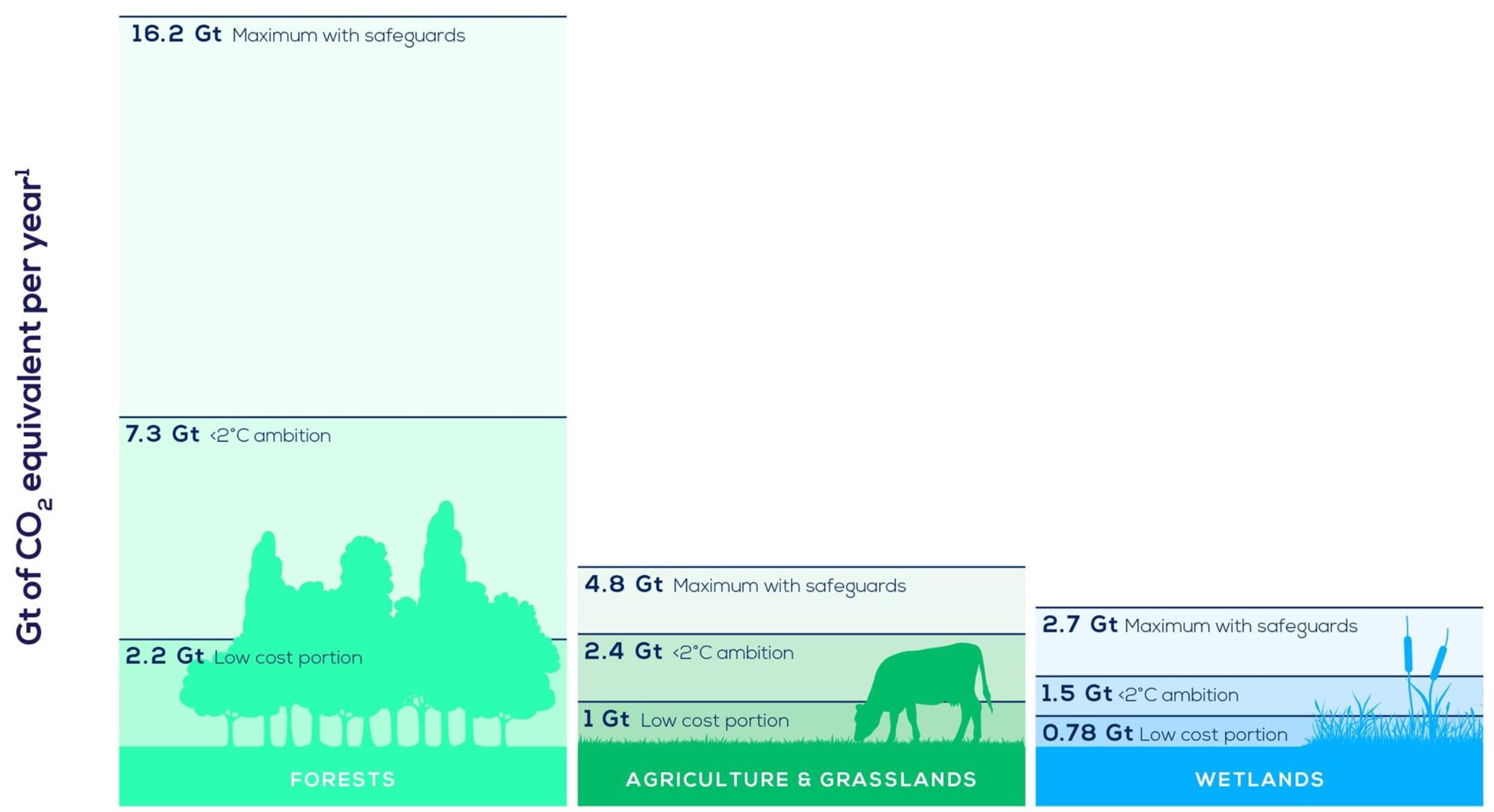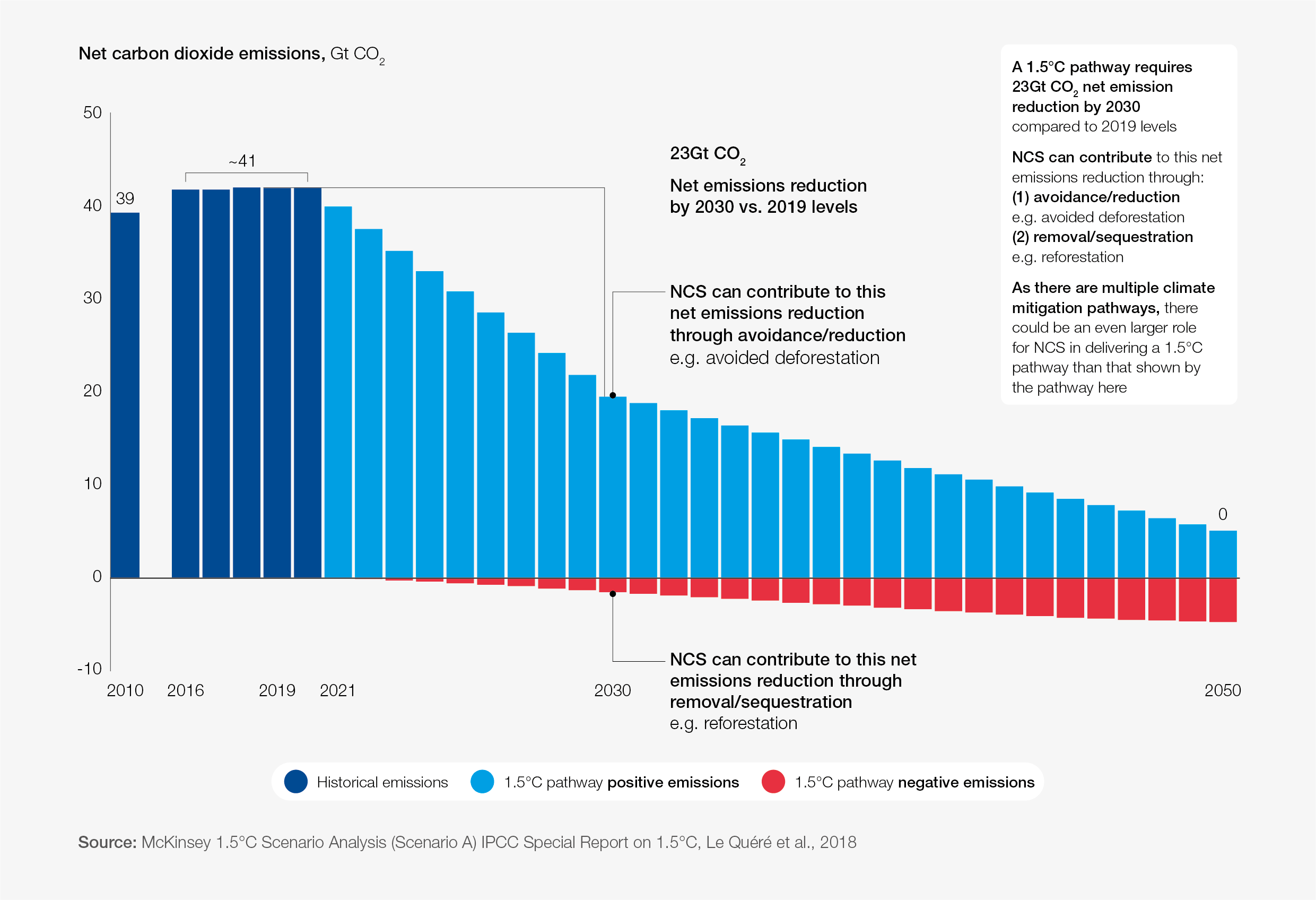Here's how natural climate solutions and carbon finance can tackle nature loss and climate change

Natural climate solutions can be used to help address the twin crises of nature loss and climate change
Image: Unsplash/Jeremy Bezanger
Stay up to date:
Climate Crisis
- Natural climate solutions can help states meet their climate change commitments outlined in the 2015 UN Paris Agreement.
- Carbon finance can be used to help address the twin crises of nature loss and climate change.
- The NCS Alliance Investment Accelerator supports efforts to raise investment commitments for credits worth reducing a gigaton of emissions by 2025.
The 2015 UN Paris Agreement set a target to cap the global temperature rise to 1.5°C. However, the current reality on the ground paints a worrisome picture.
Deforestation in countries like Brazil has recently hit a record high, at five times more than January 2021, while forest fires in the US alone burnt through more than a million acres of forest land last year.
In 2000, some 6.4 billion metric tons of carbon was held in mangrove soil. But by 2015, up to 122 million tons of this carbon has been released due to mangrove forest loss. And according to recent estimates, a horrifying 50,000 species become extinct each year.
While the exploitation of nature will only add more fuel to the already burning planet, conserving nature, or restoring it, has the potential to cut more than a third of the greenhouse gas emissions.
Climate commitments made at COP26
The international climate conference – COP 26 – in Glasgow last year saw numerous commitments made. Some 141 countries joined the Leaders Declaration on Forests and Land Use, the LEAF Coalition announced their first $1bn investment commitments for forest countries and the 12 largest traders and processors committed to a sectoral roadmap to achieve 1.5°C.
Additionally, with the Article 6 of the Paris Agreement, the conference also marked a historic agreement on the much-awaited subject – international carbon markets.
On one side, numerous businesses pledged to reduce their emissions in line with science based targets, thanks in part to the successful Race to Zero campaign.
However, despite the adoption of deep decarbonization commitments, many businesses, especially in the hard to abate sectors, still have substantive annual unabated emissions. This calls for the need to go a step beyond decarbonization and commit to compensate annually for emissions that cannot be reduced.

Natural climate solutions designed to lower emissions
Nature-based solutions are "actions to protect, sustainably manage, and restore natural or modified ecosystems, which address societal challenges effectively and adaptively, simultaneously providing human well-being, ecosystem resilience and biodiversity benefits", according to the definition adopted by the United Nations Environment Assembly in March 2022.
"They are designed to address major societal challenges, such as biodiversity loss, climate change, land degradation, food security, disaster risks, urban development, water security, as well as social and economic development," it adds.
What we generally call natural climate solutions (NCS) are then specific interventions designed to lower greenhouse gas emissions and increase carbon storage in forests, grasslands and wetlands, through conservation measures, such as halting deforestation, the adoption of sustainable land use practices and restoration practices.
Carbon credits generated through natural climate solutions offer the opportunity to businesses to compensate their emissions in a way that would also contribute to halt and possibly reverse the loss of nature.
NCS can be used to reduce within value chain emissions from forestry and agricultural sectors. Companies also use natural climate solutions to compensate for their residual carbon footprint after all measures to reduce their annual emissions have been taken. The compensation could also be retroactive and include historical emissions.
Accept our marketing cookies to access this content.
These cookies are currently disabled in your browser.
The carbon credits system has remained under scrutiny for many years with criticism including carbon leakage, projects lacking additionality and the possibility of double counting carbon reductions towards multiple countries’ climate targets.
It is, however, critical that corporate use of NCS as compensation credits always come on top of decarbonization efforts. Secondly, it is key to recognize that local communities, including Indigenous peoples, are at the heart of a successful natural climate solutions. Investments in NCS should be directed towards projects that generate socioeconomic benefits, are based on local participation and generate net biodiversity gains.

Initiatives like the NCS Investment Accelerator galvanizes corporates to go above and beyond the internal decarbonization required to meet the Paris Agreement by investing in high-quality and high-integrity NCS credits.
The NCS Investment Accelerator, co-convened by the World Business Council for Sustainable Development (WBCSD) and the World Economic Forum, is supported by six founding members who together are purchasing about 1.3Mt of carbon credits from nature in 2022. These six – Bayer, Boston Consulting Group, McKinsey & Company, Bank of America, PwC and Unilever – will roughly double their aggregate investments between 2021 and 2025.
By joining the Investment Accelerator, companies demonstrate that they have taken all the right steps towards a deep decarbonization of their own emissions, in line with the Paris Agreement, before investing in credits to balance their footprint. By sharing best practices, the accelerator will encourage other companies to engage in NCS. These quality criteria were set by the NCS Alliance, a multi-stakeholder group of civil society and private sector organizations, and published last year in the NCS Guidance to Corporates.
By 2025, the NCS Alliance Investment Accelerator aims to raise investment commitments for NCS credits worth reducing a gigaton of emissions.
Participation of leading companies from the private sector builds trust in the system and sends a clear demand signal, which is key to create confidence in the market. On the one hand, suppliers need long-term visibility to develop project pipelines. On the other, this informs policy-makers evaluating the decision to include NCS into carbon pricing schemes and regulating corporate claims on climate.
Natural climate solutions in practice
While the primary incentive of engaging in NCS is carbon sequestration and reduction, these initiatives also yield the dual benefit of providing multiple socioeconomic benefits.
In Indonesia, the Rimba Raya Biodiversity Reserve has avoided 130 million tonnes of carbon emissions and at the same time developed livelihood programmes promoting education, health, hygiene, and employment. The reserve is the world’s largest privately funded orangutan sanctuary.
On the other side of the world, in Guatemala, the Conservation Coast Project protected 59,341 hectares of threatened tropical rainforests, while supporting 4,000 people in the local communities through healthcare, education and job creation.
NCS projects must be constantly monitored
Over the past 20 years, projects all around the globe have created positive impacts for people and nature – while also tackling the climate crisis. However, it is key that these projects are consistently monitored to ensure these benefits are real and measurable.
What is the World Economic Forum doing on natural climate solutions?
The NCS Guidance to Corporates laid out a set of principles for NCS credit projects. These built on existing guidelines – the CORSIA Emissions Unit Eligibility and ICROA Code of Best Practice guidance.
Initiatives like LEAF and 1t.org – which aims to conserve, restore and grow one trillion trees by 2030 – are successfully promoting high quality interventions in, respectively, jurisdictional level forest conservation and restoration, offering businesses a useful one stop shop to learn more about these types of credits and eventually join forces with other businesses.
Don't miss any update on this topic
Create a free account and access your personalized content collection with our latest publications and analyses.
License and Republishing
World Economic Forum articles may be republished in accordance with the Creative Commons Attribution-NonCommercial-NoDerivatives 4.0 International Public License, and in accordance with our Terms of Use.
The views expressed in this article are those of the author alone and not the World Economic Forum.
Related topics:
Forum Stories newsletter
Bringing you weekly curated insights and analysis on the global issues that matter.
More on Climate ActionSee all
Nigel Topping and Gonzalo Muñoz
May 28, 2025
Tom Crowfoot
May 27, 2025
Daniella Diaz Cely
May 27, 2025
Pascale Junker
May 26, 2025
Silvio Dulinsky
May 23, 2025






